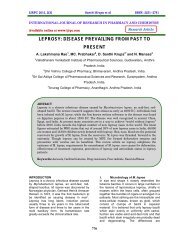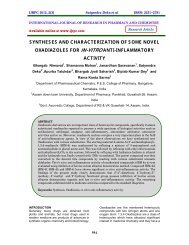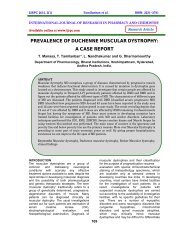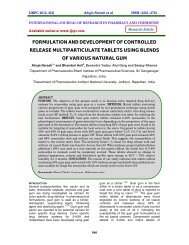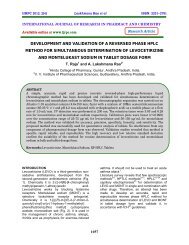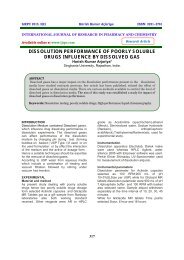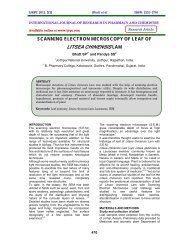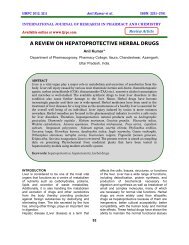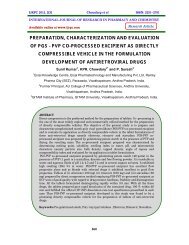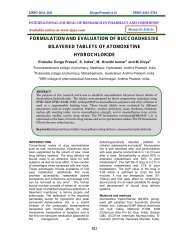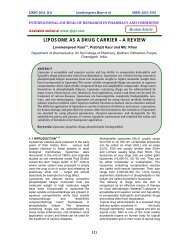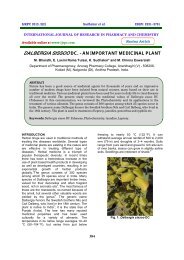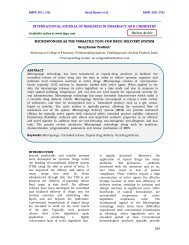microsatellite markers – a novel tool in molecular genetics - ijrpc
microsatellite markers – a novel tool in molecular genetics - ijrpc
microsatellite markers – a novel tool in molecular genetics - ijrpc
You also want an ePaper? Increase the reach of your titles
YUMPU automatically turns print PDFs into web optimized ePapers that Google loves.
IJRPC 2012, 2(2) Pokhriyal et al ISSN: 22312781<br />
1) DNA hybridization based <strong>markers</strong><br />
The DNA piece can be cloned, and allowed to<br />
hybridize with the genomic DNA which can be<br />
detected. Marker-based DNA hybridization has<br />
been widely used but the major limitation of<br />
this approach is that it requires large quantities<br />
of DNA and the use of radioactive labeled<br />
probes.<br />
This method basically <strong>in</strong>volves the follow<strong>in</strong>g<br />
steps:<br />
1) Isolation of genomic DNA,<br />
2) Its digestion by the restriction enzymes,<br />
3) Separation by gel electrophoresis and<br />
then<br />
4) Hybridization by <strong>in</strong>cubat<strong>in</strong>g with cloned<br />
and labeled probes.<br />
2) PCR based <strong>markers</strong><br />
Polymerase Cha<strong>in</strong> Reaction (PCR) is a <strong>novel</strong><br />
technique for the amplification of the selected<br />
regions of the DNA. The advantage with PCR<br />
is that even a m<strong>in</strong>ute quantity of DNA can be<br />
amplified to a large extent and hence it<br />
requires only a small quantity of DNA to start<br />
with.<br />
PCR-based <strong>markers</strong> may be divided <strong>in</strong>to two<br />
types:<br />
1) Locus non-specific <strong>markers</strong> :<br />
e.g. a) Random amplified polymorphic DNA<br />
(RAPD);<br />
b) Amplified fragment length polymorphism<br />
(AFLP).<br />
S<strong>in</strong>ce they are locus nonspecific they doesn’t<br />
give the relevant and precise <strong>in</strong>formation<br />
about the genome and the genes and the<br />
pattern of their occurrence and <strong>in</strong>heritance.<br />
Hence, the locus specific <strong>markers</strong> are more<br />
preferred.<br />
2) Locus specific <strong>markers</strong> :<br />
e.g. a) Simple sequence repeats (SSR);<br />
b) S<strong>in</strong>gle nucleotide polymorphism (SNP).<br />
Among the segregat<strong>in</strong>g populations, the<br />
phylogenetic <strong>markers</strong> are very useful for<br />
mapp<strong>in</strong>g the polygenic traits as well as<br />
Mendelian traits. The most widespread among<br />
the polygenic <strong>markers</strong> are the Variable<br />
number of tandem repeats (VNTRs) or<br />
Microsatellites. The locus-specific probe fails<br />
to cover it and shows the highly polyallelic<br />
fragment length variation. For e.g. the tandem<br />
repeat loci associated with rRNA genes which<br />
are concentrated at nucleolar organiz<strong>in</strong>g<br />
regions (NORs) of certa<strong>in</strong> chromosomes of an<br />
<strong>in</strong>dividual. Similarly, most VNTRs loci get<br />
centered <strong>in</strong> pro-term<strong>in</strong>al regions of human<br />
chromosomes. Therefore, the desired density<br />
of <strong>markers</strong> is not provided. This difficulty is<br />
overcome <strong>in</strong> Microsatellite or SSR (Simple<br />
Sequence Repeats) loci 2 .<br />
What are Microsatellites?<br />
The term Microsatellite was first co<strong>in</strong>ed by Lit<br />
and Lutty. These are also known as the<br />
Simple sequence repeat (SSR) or Short<br />
tandem repeat (STR). These are the stretches<br />
of DNA, consist<strong>in</strong>g of tandemly repeat<strong>in</strong>g<br />
mono-, di-, tri-, tetra- and penta- nucleotide<br />
units, which are arranged throughout the<br />
genomes of most eukaryotic species. For<br />
example,<br />
AAAAAAAAAAA would be referred to as (A) 11<br />
GTGTGTGTGTGT would be referred to as<br />
(GT) 6<br />
ACTCACTCACTCACTC would be referred to<br />
as (ACTC) 4<br />
They are often represented as (CA) n repeat,<br />
where n is variable between alleles and CA is<br />
the most commonly found repeated units of<br />
cytos<strong>in</strong>e <strong>–</strong> aden<strong>in</strong>e pair <strong>in</strong> the human genome<br />
.The existence of d<strong>in</strong>ucleotide repeats- poly<br />
(C-A), poly (G-T) (i.e. an alternat<strong>in</strong>g sequence<br />
of cytos<strong>in</strong>e and aden<strong>in</strong>e, with on the opposite<br />
strand of the DNA molecule, alternat<strong>in</strong>g<br />
guan<strong>in</strong>e and thym<strong>in</strong>e) was first documented<br />
almost 15 years ago by Hamada and<br />
colleagues. Subsequent studies by Tautz and<br />
Renz have confirmed both the abundance and<br />
ubiquity of <strong>microsatellite</strong>s <strong>in</strong> eukaryotes which<br />
are <strong>in</strong>herited <strong>in</strong> a Mendelian fashion 3 .<br />
Why Microsatellite Markers are Preferred<br />
over other Molecular Markers? 3<br />
There are several widely used marker types<br />
available for <strong>molecular</strong> ecology studies, and<br />
many questions can be addressed with more<br />
than one type of marker. Microsatellites are of<br />
particular <strong>in</strong>terest to ecologists because they<br />
are one of the few <strong>molecular</strong> <strong>markers</strong> that<br />
allow researchers <strong>in</strong>sight <strong>in</strong>to f<strong>in</strong>e-scale<br />
ecological questions. Regardless of the<br />
question, a <strong>molecular</strong> marker must<br />
fundamentally be selectively neutral and follow<br />
Mendelian <strong>in</strong>heritance <strong>in</strong> order to be used as a<br />
<strong>tool</strong> for detect<strong>in</strong>g demographic patterns, and<br />
these traits should always be confirmed for<br />
any marker type. The desirable traits of<br />
<strong>microsatellite</strong>s compared with other marker<br />
types such as allozymes, amplified fragment<br />
length polymorphisms(AFLP), sequenced loci<br />
and s<strong>in</strong>gle nuclear polymorphisms (SNP),<br />
focused on both practicalities and ecological<br />
considerations are as under<br />
1) Easy sample preparation 3<br />
An ideal marker allows the use of small tissue<br />
samples which are easily preserved for future<br />
use. In contrast to allozyme methods, DNAbased<br />
techniques, such as <strong>microsatellite</strong>s, use<br />
PCR to amplify the marker of <strong>in</strong>terest from a<br />
m<strong>in</strong>ute tissue sample. The stability of DNA<br />
398



